FractalNet featuring the DataGlove
Out-of-this-world fashion with function: clothing or accessories for earth or space wear!
Every space traveler – even the robotic ones – should feel? their very best during the journey, infused with the very best data and technology available. Earthlings can follow suit. Design a space data-tech-fashion wearable in the form of clothing or accessories that will collect or distribute data and technology in the following categories:
Design for Interconnectivity (staying more connected to team, community, and tools)
- enhance the work/life experience of humans and/or capabilities of robots
Design for Health (biometrics, physical and emotional health, and/or environmental alerts)
- maintain or improve the health and well-being of the human
- provide early warning for unhealthy environmental factors (air quality, radiation, outgassing, temperature)
Design for Entertainment (sights, sounds, music, activity)
- enhance the human experience whether during work or play

The Problem:
Very soon, we'll have astronauts exploring underground environments on the Moon, Mars, and asteroids. Radio communication will be blocked by obstacles such as cave walls, habitats, landscapes, and other line-of-sight issues. This leads to lack of (or short range) communication, unknown health status for astronauts, and unable to respond to certain emergency situations.
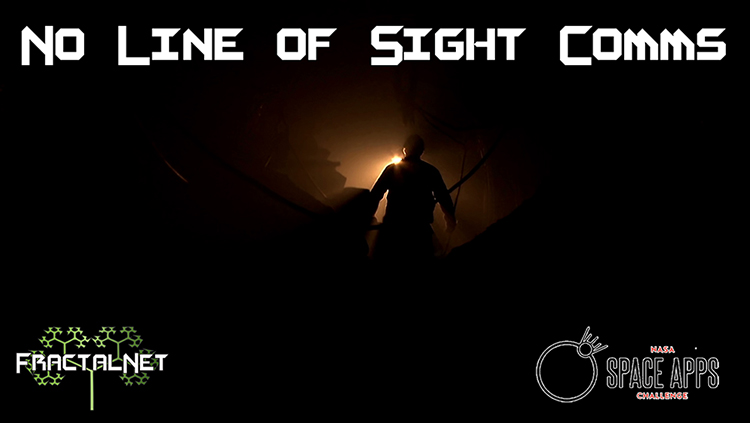
The Solution:
FractalNet, consists of a wearable network of sensors that measure various parameters concerning an astronaut's health, the integrity and status of his/her spacesuit, and information about location and movements during an excursion on and beneath a planetary surface. It includes the DataGlove, a Human Machine Interface (HMI) to communicate information to the wearer, and to other personnel and equipment participating in the operation
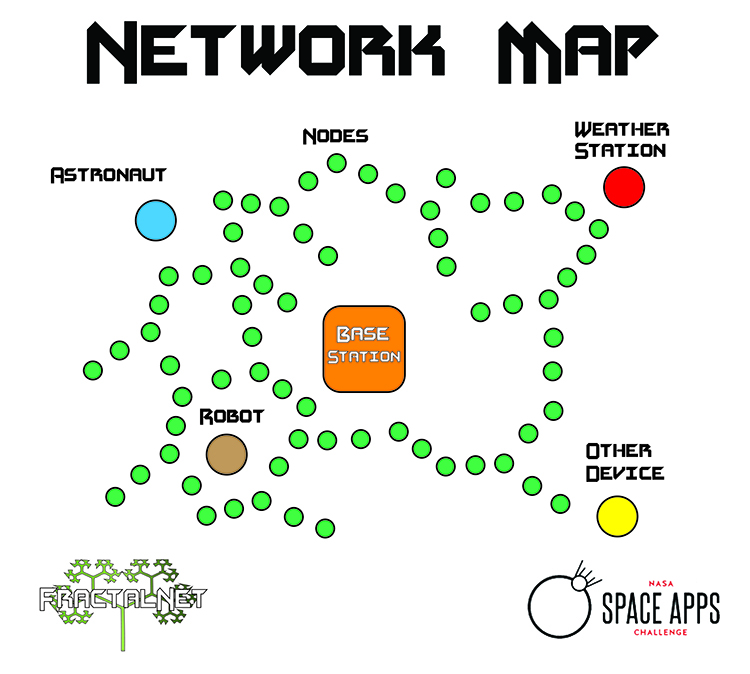
The DataGlove provides an interface to the nodes, BaseStation, astronauts, robots, and everything else on the network. If an astronaut trips and falls, a fellow astronaut will receive an alert based on the change in vitals. The astronauts can then use voice, text, or text-to-speech to communicate and see if everyone is okay.
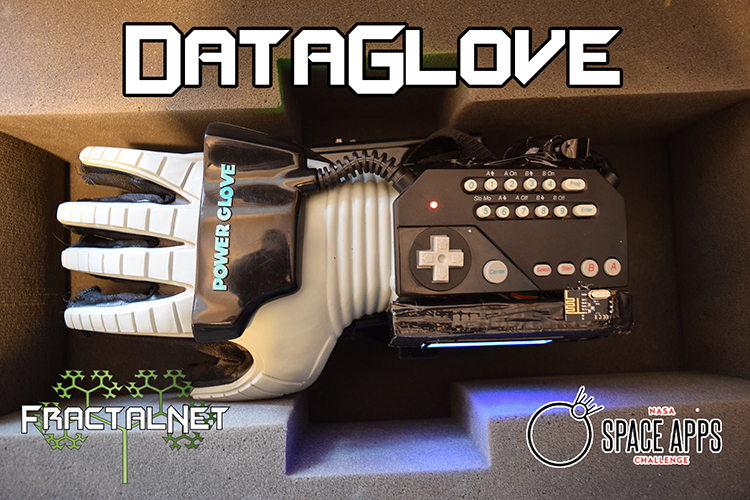
The DataGlove can also be used for entertainment, such as piloting a quadcopter while the astronauts take a break in the mess hall.
The network implements a recursively branching or tree topology. At the root of the network is a base station, a device that is permanently or semi-permanently placed near the entrance of the cave system and that serves as both a manager of the FractalNet network in the cave and a gateway to other communication systems in the vicinity. Explorers in the cave can communicate among themselves, and also with external vehicles, habitats, and spacecraft as needed, using the protocols appropriate to those networks. Several branches can split off from the root, penetrating in different directions into the cave system.
The fixed nodes provide a stable network topology within the cave system and transport network traffic between mobile devices that operate at the application layer of the OSI stack. These active devices produce and consume the data carried by the network, which consists of telemetry related to the health and physical condition of the astronauts and their suits, audio and video, telemetry, instrumentation and command information associated with robots that accompany the human explorers, and data produced by equipment that is placed within the cave. The mobile elements of an exploration party will generally move together, and comprise a travelling "entourage subnet" that needs to connect to the network at only one point. One of the mobile elements serves as the root of the entourage, which reproduces the branching structure of the network as a whole, recursively. Thus the name "FractalNet." The expedition can travel as several independent, geographically isolated teams, each forming its own entourage subnet and remaining in contact with the other parts of the expedition.
Radio tag nodes are deployed dynamically on FractalNet. After commissioning the node via the DataGlove, the BaseStation will assign the node an address, establishing its place in the network. Nodes are able to be used in several situations. Nodes relay communication between other devices on the network. They can also be used to log places of interest. As an astronaut commissions a node, they use the DataGlove to record a voice or text message when they come across an interesting subject. This voice, text, and position information is then sent back to the BaseStation and all other devices on the network. When the astronaut moves out of range from the last node, an alert on the DataGlove will prompt the astronaut to commission a new node so that they will remain connected to the network.
DataGlove features:
Human Machine Interface to all devices on FractalNet
Calculates distance using ultrasonic sensors
Determines position in space using a six degree-of-freedom sensor
Uses flexible resistors to determine finger manipulation
Contains nRF24L01 radio to stream information
Displays vital information on LCD screen
Uses a text-to-speech module to deliver audio messages
Heart rate and other health sensors
Provides entertainment platform for crewmembers
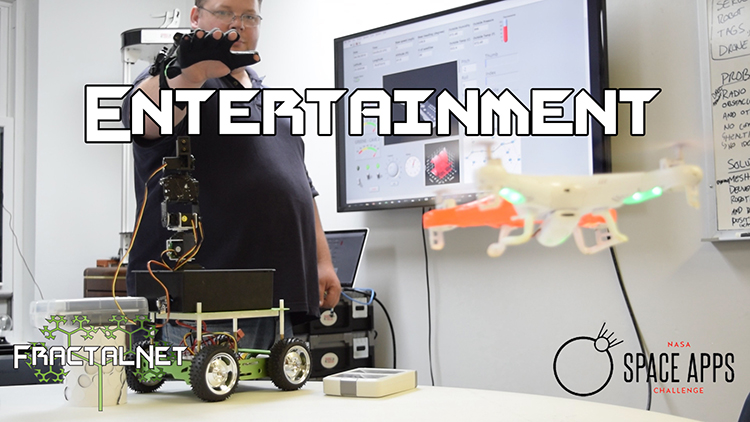
BaseStation features:
Logs and routes all traffic on FractalNet
Displays health information from astronauts
Monitors position tracking (GPS on Earth), weather, and seismic activity and will alert the crew of any emergencies
Interfaces with DataGlove for gesture control
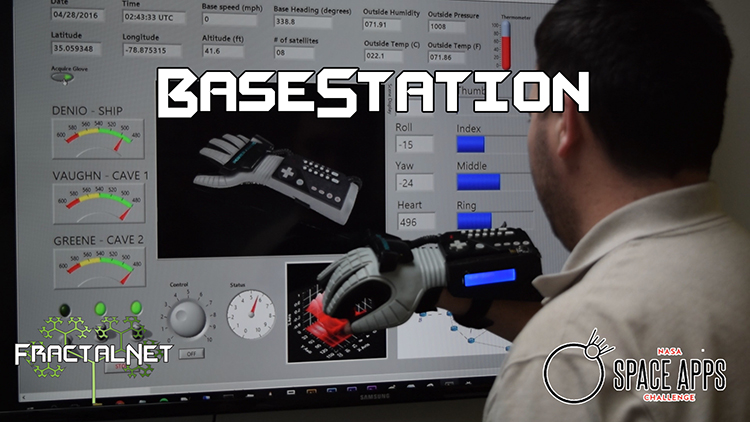
Radio Tag node features:
Relays communication
Logs / transmits subjects of interest as determined by the astonaut
Provides ongoing extended range communication
Allows for tracking of astronauts and other devices on FractalNet
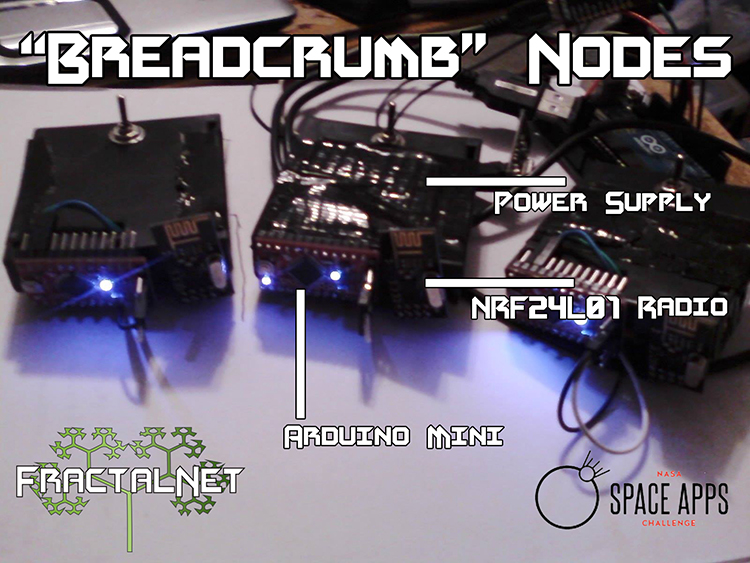
Robot features:
Allows for travel which would be dangerous for astronauts
Can be remotely piloted by astronauts
Able to lift heavy objects as well as perform drilling, etc.
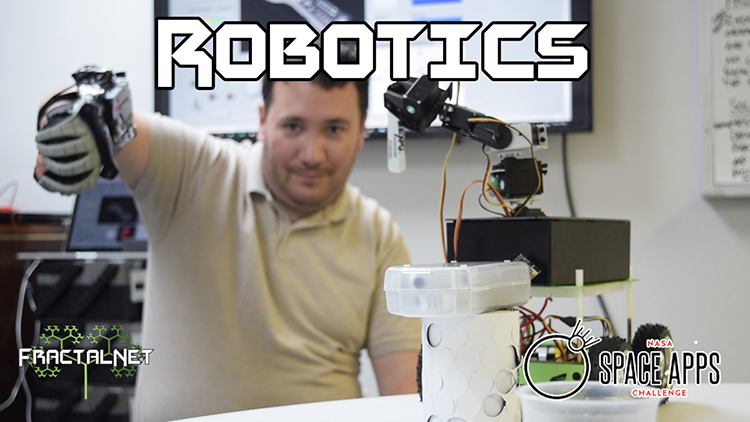
Other Applications for FractalNet:
Current mine/cave systems on Earth
Any place where line of sight communication is an issue
Uses for temporary networks
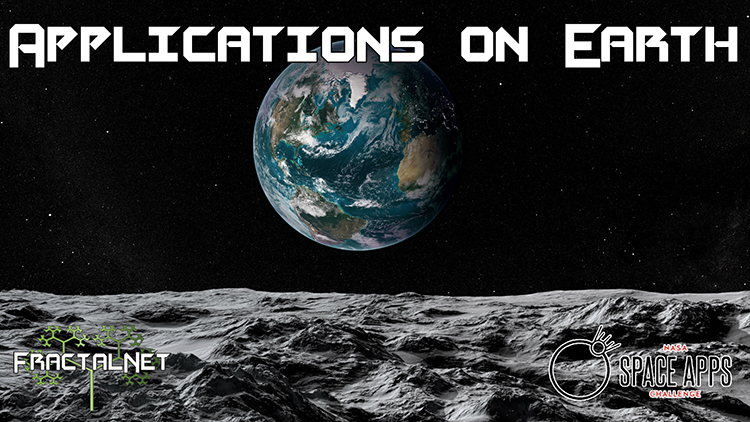
Future Development of our project:
Create protocol for dynamic address assignment for nodes and other devices on network
Relay communication between nodes and create mesh network
Code button functionality for DataGlove
Code ultrasonic distance feature for DataGlove
Add driving abilities for Robot
Develop more DataGloves
Integrate smaller LCD screen/speaker for DataGlove
Team members: Andrew Denio, Tony Vaughn, Joe Greene
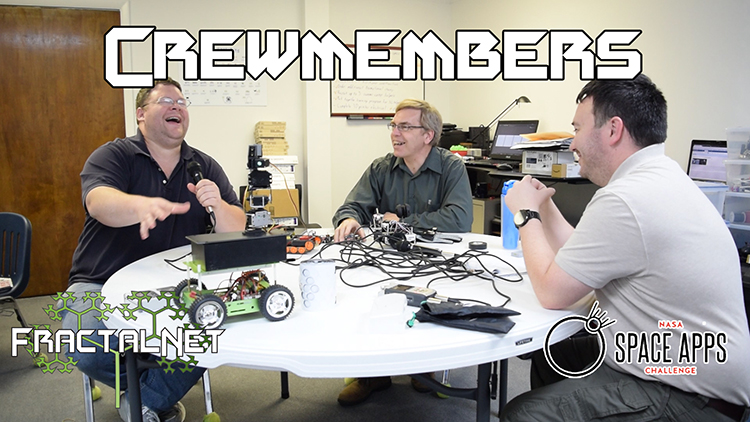
(Detailed "use case" and additional pictures are available through this project's GitHub link)
GitHub, Google, YouTube, and the various example codes provided by the Arduino community (THANK YOU!). Linked code in GitHub contains acknowledgement for code libraries, etc.
We built our competition system around a modified Nintnedo Power Glove and Arduino microcontroller boards. The radios consisted of a nRF24L01 transceiver module controlled by a 3.3V Arduino Mini Pro.
http://www.arduino.cc/en/Main/arduinoBoardProMini
http://arduino-info.wikispaces.com/Nrf24L01-2.4GHz...
A demonstration base station interface was created as a LabVIEW vi.
http://www.ni.com/labview/
The power glove included an LCD display, a radio module, a heart rate sensor, and an EMIC2 text to speech synthesizer.
https://www.parallax.com/product/30016
http://pulsesensor.com/
Software for the radios was based on the libraries developed by TMRh20
https://github.com/TMRh20
MIT Open License: https://opensource.org/licenses/MIT
FractalNet GitHub Link: https://github.com/ExpeditionSTEM/SpaceApps2016
Related Terrestrial Technologies:
http://www.tunnelradio.com/mining/ Tunnel Radio that uses "leaky feeders" to connect nodes around corners.
http://www.iwtwireless.com/mining/communications-t... Wireless mesh used in mining.
http://cavingnews.com/20130308-cave-radio-test-ext... Ham radios in caving.
Inspirational and helpful Power Glove Hacks:
NJKL44's Power Glove Hack: http://www.instructables.com/id/Hacking-a-Powerglo...
Biphenyl's Power Glove Hack: http://www.instructables.com/id/Power-Glove-20th-A...






